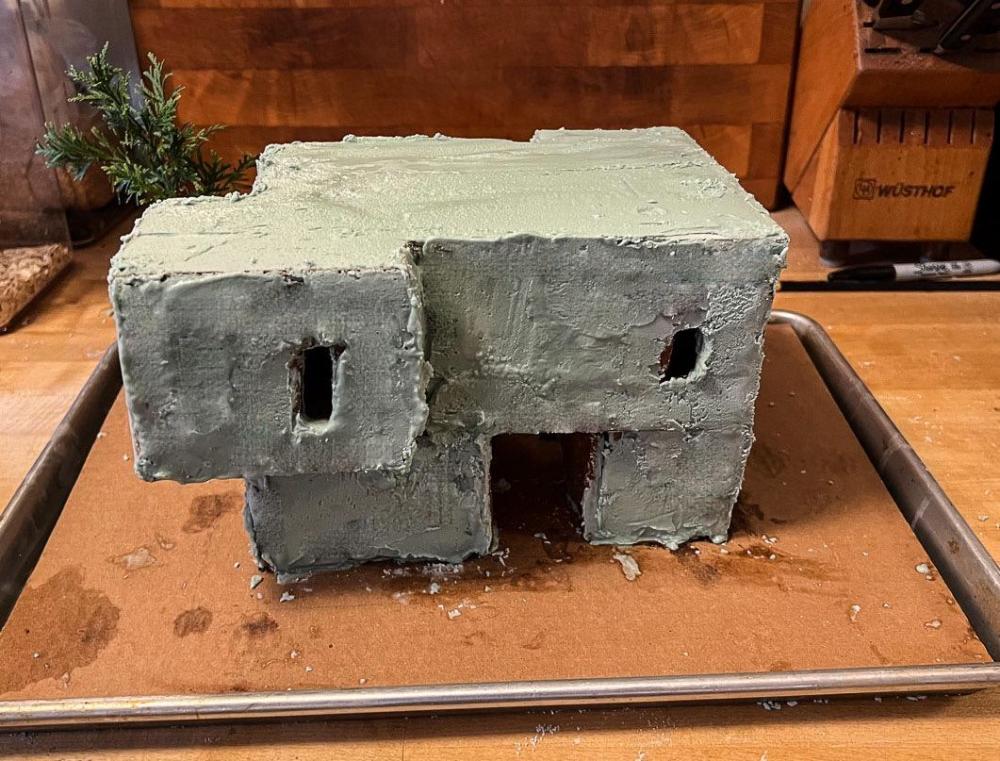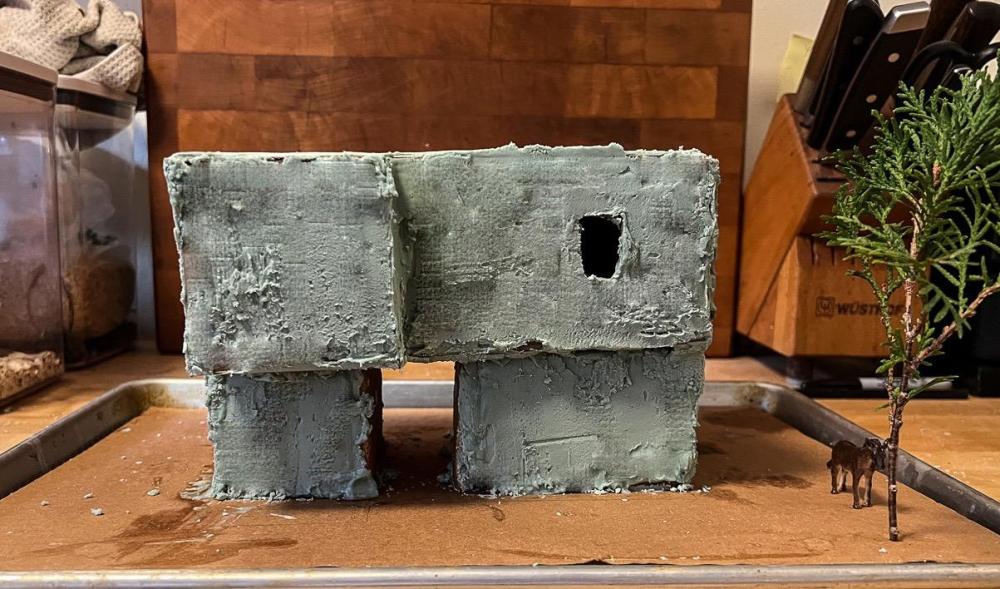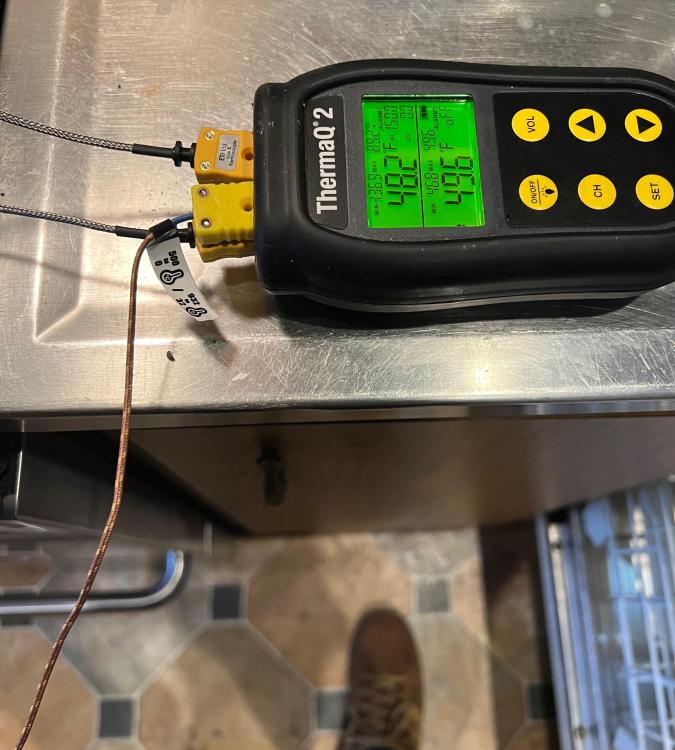-
Posts
5,150 -
Joined
-
Last visited
Content Type
Profiles
Forums
Store
Help Articles
Posts posted by paulraphael
-
-
16 hours ago, paulraphael said:
The contest is tomorrow. This will be a test of some architects' sense of humor.
They sent us all a prefab gingerbread house kit which I didn't find inspiring enough to open.
I came in 2nd! The winner followed the rules.
-
 5
5
-
 5
5
-
-
2 hours ago, JeanneCake said:
I like it!! Pretty cool inspiration and execution. You won first prize, right?
The contest is tomorrow. This will be a test of some architects' sense of humor.
They sent us all a prefab gingerbread house kit which I didn't find inspiring enough to open.
-
 4
4
-
-
Here's how it turned out.
Basically, if Grandma was Le Courbussier.
The royal icing, plus 1 drop of black food coloring, plus my ham-fisted icing skills, gave some pretty realistic poured concrete.
Crumbling, delaminating, post-Soviet looking concrete, but those are just fancy words for rustic charm.
-
 10
10
-
 3
3
-
-
If you're using truly hot wok burner, then I don't think there's any point to seasoning it ... those things will incinerate any seasoning just like a self-cleaning oven. If you're using the thing at more normal sauté temperatures then you can treat it just like a cast iron skillet. The sunflower oil you're using is fine; it's got a lot of unsaturated oil that will polymerize nicely. But it will take quite a few coats (preferably very thin ones like Scott says) before it really helps. And you have to cook them on at a temperature that's past the smoke point by a little bit. A good coating is not just polymerized oil, but also partly carbonized. That means you need to make some charcoal.
-
Tara gum is a galactomannan similar to guar and locust bean gums. Supposedly its properties are somewhere between those of the other two. LBG has strong ice crystal suppression, and relatively little noticeable effect on the ice cream's thickness or chewiness. Guar is weaker at ice crystal suppression, but has a strong thickening effect. The two are superadditive; using them together allows you to use a lower total quantity than using any one of them alone.
I imagine tara gum is a pretty good single-gum solution based on this. It wouldn't offer the flexibility of mixing and matching guar and LBG.
-
 1
1
-
-
11 minutes ago, heidih said:
Are there rules like it has to be all edible? A lot of the gingerbread houses are meant to be storable for following year(s) so you can go pretty firm on the dough especially is nobody is going to taste test it.. Like the ones our late @David Ross shows in the links. What you use for the "glue" is key. Also if can have non-edible parts think of how wedding cake decorators stabilize tiers. Sounds like a lot of fun. Hope you post pics from the contest.
Excellent question. I like the idea of it being edible, so it doesn't go to waste. But this is all going to happen on zoom. So we could get away with faking it.
I have to leave town the next day so will probably try to give it away, preferably to friends with kids. My partner and I are not going to eat a whole concrete bunker by ourselves.
-
6 hours ago, Mjx said:
I'd just go with a royal icing, add a bit of finely-ground edible charcoal, and press some canvas against it before it fully hardens, to give a rough, dull texture.
Is an icing a must? I once thought it would be a great idea to make empandas with buckwheat flour, and although they were tasty, the crust was a surprise, a concrete grey; buckwheat flour may be an option that would let you skip an icing.
This sounds like a great idea for the icing.
Skipping the icing and doing a concrete-like dough does look like the most pro option. I just don't have enough gingerbread experience to improv this and have confidence that it will work. A structural collapse would ruin Christmas. So unless you know of a tried and true recipe ...
-
On 12/14/2021 at 10:03 PM, heidih said:
Done my share of gingerbread houses but you brought me up confused at "poured reinforced concrete", Reinforcement is not an actual form but concrete that is reinforced by underlying re-bar or mesh. Do you have an image you are trying to go for?
Anything in these look or sound like what you want?
https://forums.egullet.org/topic/159892-the-gingerbread-house-topic/
https://forums.egullet.org/topic/96340-gingerbread-houses-pictures/
https://forums.egullet.org/topic/96367-gingerbread-houses-tips-techniques/
Yes, I don't need actual rebar in my cake ... poured reinforced concrete is just how an architect would describe a structure, and tells you a bit about the esthetics.
Here's a typical brutalist building ...
My gingerbread house won't be this awesome, because I'm not a genius, but it's something to aspire to.
BTW, I'm working for a company that's involved in architecture, and we're having a gingerbread house contest for our holiday party, so I just thought this would be funny.
Photo: Arch Daily https://www.archdaily.com/963115/brutalism-in-european-schools-and-universities-photographed-by-stefano-perego/60b42c1cf91c81fb8200003d-brutalism-in-european-schools-and-universities-photographed-by-stefano-perego-photo?next_project=no ©Georges Adilon
-
 4
4
-
-
If you were to make a gingerbread house in the brutalist architectural style, and wanted the icing to look like poured reinforced concrete, and if you wanted the icing to be easy to make and easy to apply (because you're not much of a cake decorator), and you wanted the icing to have good longevity (because people might not be in a huge hurry to eat a brutalist gingerbread house), what kind of icing might you use?
-
 1
1
-
-
Not trying to be a downer, but if we include the ecological / societal costs of raising meat, it should expensive as hell.
By these standards Australian lamb should cost $100/lb.
-
 1
1
-
-
Before ditching vitamix for blendtec, check out these teardown videos with my favorite potty-mouthed Canadian machinist:
My money's on the Vitamix motor.
Edited to add: he shows where there's a fuse in the VM motor ... it's possible that's all that needs to be fixed in the blender that went up in smoke.
-
 2
2
-
-
Japanese Knife Imports doesn't get mentioned enough around here. It's one of the best shops anywhere for knives and information. The founder, Jon Broida, knows as much as anyone and is almost unreasonably generous with advice. He even talked me out of buying an expensive knife once ... I was complaining about one of the qualities of my gyuto, and was interested in one he sold in a similar style (there was a big buzz about it online). Jon said I probably wouldn't notice any difference. He'd actually owned my knife, and another model I was considering, and had used them both when he cooked professionally. So it wasn't just speculation.
The shop mostly sells knives you won't see elsewhere. Jon works with small Japanese makers and has them create lines of knives just for his shop to sell. He rebrands them with "Gesshin" plus the maker's mark. The Gesshin Ginga line, for example is made by Ashi Hamono. They're similar to the Gingas Ashi sells directly from Japan, but they're heat treated to a higher hardness level, have a more smoothly rounded spine and choil, and a nicer handle. And they cost a little more. Jon's got several lines of knives, all by different makers. And his own line of stones. I just picked up a Gesshin 6K splash-n-go stone and it might be the nicest I've used.
So the TL;DR if you're looking for a knife (and don't want to get bogged down in the details) is call JKI and just get whatever Jon tells you to get.
-
 2
2
-
-
5 hours ago, Katie Meadow said:
And what do you think the recipe really called for? Cloves or chives or olives?
No one even remembers what she was trying to cook. The answer is lost forever.
Edited to add ... I never even thought of olives!
-
 1
1
-
-
This is less a problem with recipes than with playing telephone ...
When my mom was newly married, in the 1950s, when a woman's entire value to the universe hinged on knowing how to cook (which she didn't), she survived by way of desperate phone calls to her best friend to get instructions.
One day the recipe she wrote down included "clives."
There were no clives in the kitchen.
She ran all over Manhattan looking for them.
One grocer after another said, "no, we don't have those."
Not one grocery professional did her the courtesy of saying, "lady, there's no such thing."
I have no idea how she managed to save dinner.
Whenever I go home for the holidays now I find a random jar in the pantry and label it CLIVES.
-
 9
9
-
-
I've got one of those wire shelves above one of my counters. I use a short length of cord and a keychain carabiner to hang the bag. It's a bit awkward but it works.
-
On 11/24/2021 at 10:16 AM, blue_dolphin said:
Almost all the thyme ice cream recipes unhelpfully give the amount of thyme in "sprigs" but this one calls for 30-40g for what's probably ~ a 1 qt batch. Thyme varies a lot by variety, age, etc. but at least this gave me a starting point. I used 20g for a half batch, ~ 1 pt. When I tasted the mix before freezing, I thought it was both too sweet and too much thyme. If I'd had more yogurt, I'd have mixed up some neutral base to mix in but I was out so I just froze it as it was. As mentioned, the end result was still quite sweet but the thyme seemed more mild and overall helped balance the sweetness.
That's a whole lotta thyme. How did you infuse it? I usually use 10g / liter, and it's strong.
And yeah, anyone who gives you "sprigs" as a measure needs their cookbook writing license revoked.
-
 2
2
-
-
4 hours ago, Smithy said:
You may have (a) given me the justification to pull the trigger on this and (b) given me an idea for what I want for Christmas!
I can't quite see in the display, though: is there a third spot in the display where the oven temperature is shown? I see only two temperatures, one with an alarm set, the other with no alarm set.
It takes up to 4 probes but only shows readouts from 2 at a time. It cycles between them every few seconds, or you can move it to the next screen by hitting the arrow button.
if you’re only using 1 or 2 probes, it stays on the relevant screen.
You can set alarms individually for the probes.
it doesn’t come with probes. You can buy different types from thermoworks, or use any other company’s K-type thermocouples. Just be aware that quality and accuracy varies quite a bit, as does the temperature range that the wires can survive.
-
 1
1
-
 1
1
-
-
I’ve been wanting something like this for years. Ovens are untamable beasts, and turkeys are fickle math problems. Never has there been a better justification for TMI. Especially on a year like this when I wasn’t hosting, but would be a guest at 2 separate holiday dinners, with a sense (based on experience) that I’d be asked for some help (what temperature do you think? How long? Is it ready?). Thrmocouple probes to the rescue. One in the thick slow part, one in the breast, and one open air to keep an eye on the oven. No more surprises! No more guessing! No more thinking! Yes, more wine for the guest cook.
-
 9
9
-
 1
1
-
-
18 hours ago, dcarch said:
Once the pressure is reached (when there is steam coming out the jigger valve), you have the maximum temperature achievable. It does not matter how hot the fire is.
Which means, you can turn the heat way down once it reaches pressure. My 10qt cooker holds pressure fine with the fire turned nearly off. Any higher setting just wastes energy and makes noise.
-
I suspect you'd want something as thin and light as possible. You don't want heat retention, and you don't need to spread uneven heat evenly. You just want something that will respond as quickly as possible.
-
I don't understand why those foil pans exist, unless there are really lots of people who decide to host thanksgiving, but are sure they'll never use their oven again ever.
If you don't care about deglazing on the stove top (sad!) just get a half sheet pan. You'll use it for a million other things, and you can probably pick one up for next to nothing. You'll even benefit from more even browning than you get in a roasting pan. You just have to be careful not to let the bird slip over the low sides and onto the floor.
-
 3
3
-
-
On 11/17/2021 at 3:03 AM, liuzhou said:
All 'newspapers' just reprint press releases uncritically. Seeing the same garbage on multiple sites is normal.
See
And the followup comments.
TL;DR: All sweeping generalizations are wrong.
-
 1
1
-
-
That headline really stood out for me also.
I didn't read the article. Usually by the time I'm done eating the produce bag I'm too full for the stickers.
-
 2
2
-
 1
1
-
 2
2
-
-
Anyone try Ford's gin? I discovered it last year and it's become my favorite. It unseated Plymouth in my liquor cabinet. For context, I mostly think of gin as the primordial ooze from which a Negroni rises. So many of the gins that work great in other cocktails (Hendricks, etc.) aren't really on my radar.
Plymouth for me made an interesting negroni. I understand why it's a controversial choice. It's on the subtle side. Ford's is much more juniper-forward, but it has Plymouth's earthiness and oiliness, which makes it work great in this cocktail. It's also a few bucks cheaper. Only drawback is it's a little harder to find.
-
 1
1
-








Gotten any fun stuff lately?
in Kitchen Consumer
Posted
New coffee grinder (for brewed coffee only). Fellow Ode.
A nice step up from my trusty old Baratza, that just broke for the 2nd or 3rd time. The great thing about Baratza is they sell all the replacement parts, and post all the DIY videos. But the gizmo I need is out of stock for a few weeks, and we need coffee now!
My friend who owns my favorite coffee shop (and does all the roasting) recommended this one. He roasts very light, which is a challenge for grinders that don't have burly motors and burrs ... possibly why my grinder kept breaking.
I plan to repair the Baratza and give it to my mom, who has a Capresso that doesn't work right (and that company doesn't sell parts).